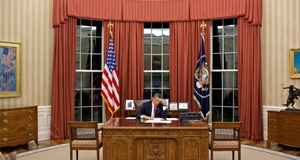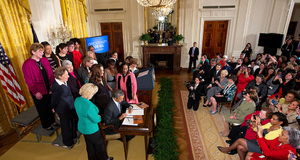The Obama PresidencyThe Urban President: Assessing Obama's Community Redevelopment PoliciesConcentrations of Poverty and the Obama PresidencyWith the 2008 election results and voter turnout rates as evidence, Barack Obama’s mandate for change in America’s metropolitan areas became tangible as soon as the final election results were tallied. Since the decline of the country’s major cities in the 1950’s and 60’s, one of the most important, pressing, and ongoing issues facing urban centers has been concentrated poverty and the ensuing intergenerational transmission of disadvantage. Hopes that more effort would be devoted to addressing these problems rose as a young President attuned to the issues of the urban poor entered office. However, a more immediate issue was at hand with the American economy in the worst economic downturn since the Great Depression. According to the Bureau of Labor Statistics (BLS) report on the Recession of 2007-2009, the national unemployment rate rose to a high of 9.5% during the recession.25 The drop off in employment nationwide was disproportionate across geographies and race. Though the recession statistically ended in 2009, the effects of decreased firm investment in employment and growth continue to be felt in many of America’s older urban centers in the “Rust Belt” and South, where unemployment rates remain much higher than the national average. Additionally, at the peak of unemployment during the recession, African-Americans were unemployed at rates around 16.5% and Hispanics at rates around 13%, while White Americans hovered around only 8% unemployment.26 The broad effects of the economic downturn on consumer spending, financial and housing markets, personal savings, and the availability of credit during the early Obama years have been well documented. Consequently, the first economic development policies of the Obama Administration had to take on the macro effects of the recession. After assuming the office, President Obama was tasked with implementing the Troubled Asset Relief Program (TARP) – the $700 billion financial bailout package passed during the final days of the Bush Administration.27 TARP was followed by a number of measures to protect mortgages, lower interest rates, and sweeping financial reform through the Dodd-Frank Wall Street Reform and Consumer Protection Act.28While the Obama Administration was dealing with the economic crisis at the national level, wealth disparities and poverty rates at the neighborhood level grew. Though the economic recession was certainly a catalyst, the population living extreme and concentrated poverty has risen by one-third in the 2000’s after steadily declining in the 1990’s.29 As of 2010, 46.2 million Americans lived in poverty, of which nearly 9 million lived in concentrated poverty neighborhoods where over 40% of residents live below the poverty line.30 Just as the effects the recession had on unemployment, the distribution of extreme poverty displays a number of serious racial and geographic disparities. Central city populations are over four times as likely to live in neighborhoods of extreme poverty where the racial make-up is 44.6% African-America and 33.9% Hispanic.31 Beyond the growth of this phenomenon, racial disparities, and the normative fact that no one should be subjected to poverty, let alone extreme poverty, why is tackling the concentrated poverty issue so important and pressing? An extensive analysis published by the Brookings Institution delineates five keys reasons as to why the re-emergence of this issue is important to policymakers. The first reason lies in the long-term implications of poor education outcomes in the youth of these neighborhoods.32 Community schools with limited resources tend to be inundated with students in need of greater social welfare to counteract social issues inherent in poor households. Additionally, larger class sizes, a less experienced stock of teachers, poor funding for after-school programs, and weak truancy oversight have shown to indicate lower test scores, increased dropout rates, and a higher frequency of students being held back one grade or more.33 Though the outcomes of poorly educated children bode disastrous consequences for the national economy as a whole, disparities in outcomes between urban poor communities and their counterparts indicate even wider consequences for economic revitalization and racial equity. Low education attainment by students in these communities is certainly a pressing issue that must be addressed, but much of its effects are seen in the long run. However, immediate and continued effects promulgating poverty and a number of issues to still be discussed are due to the lack of private-sector investment in these neighborhoods. Neighborhoods of concentrated poverty are less attractive to investors and employers because of the high concentration of low-skilled, low-income labor pool.34 The lack of investment leads to the third reason for why concentrated poverty must be addressed: an inability to accumulate wealth and climb out of extreme poverty. A lack of local business competition has shown to drive up the costs of basic goods, 35 increasing the marginal cost of each dollar of income spent making it more difficult to save money. Additionally, this lack of local investment not only reduces savings further by forcing residents to spend more money on their commute, but also continues to depreciate home values, which is often the only form of long-term assets in these communities.36 The combination of higher basic good costs, the decentralization of economic opportunity, and the socio-psychological stresses of poverty have proven to create a double burden on individuals and local governments.37 Neighborhoods of concentrated poverty are plagued with higher crime rates – especially violent crime rates – and higher incidents of chronic diseases such as asthma and diabetes, as well as mental health issues associated with substance abuse, depression, and inadequate medication and counseling services.38 These issues in and of themselves are reason for policy remediation as children born into these poor environments are likely to be subjected to the same ills as they mature. However, this problem of high crime rates and poor health outcomes are doubled more broadly as local governments must spend more of their limited tax revenue on policing and public health initiatives.39 It is clear that the effects of concentrated poverty are severe and that its re-emergence should serve as a call for policy remediation. Measures to address these issues are, of course, expensive and those implemented so far have not fully addressed the issue of extreme poverty. In order to more properly tackle this issue, two phenomena appear to be the root cause of the continuation of extreme poverty neighborhoods. First is the socio-economic phenomenon of intergenerational transmission of disadvantage. This refers to the extent to which and individuals socio-economic circumstances are passed down generationally, whereby younger generations are inherently subjected to less income mobility in respect to different cohorts of socio-economic status.40 For residents of neighborhoods in concentrated poverty, the result is a systemic continuation of lower educational attainment, poor health outcomes, and lack of private-sector investment that leads to the persistence of poverty across generations. In the case of African-American youth, 40% of boys and 47% of girls raised in the lowest quintile of income remain there, while whites have only an 18% chance of the same outcome.41 The root of this problem lays in the second phenomenon that must be addressed by policy remediation: spatial mismatch. Spatial mismatch is the physical disconnect between where low-skilled jobs and low-income housing are located.42 Three significant factors promulgate the continuation of this phenomenon in urban neighborhoods. First, labor demand had shifted from inner-city neighborhoods to high-growth suburban areas, sparking the initial private-sector divestment during the decline of the country’s cities.43 Though the re-emergence of the urban economy’s role in the national economy over recent years has clawed back some of this shift, the socio-economic ills of these neighborhoods have not supported a recentralization of business to their specific communities. Secondly, the historic racial discrimination in mortgages and home ownership have drawn very real lines of segregation in the country’s metros that have not be broken down to this day.44 Finally, residents lack adequate transportation and social networks to get to job centers outside of their community.45 Until job centers return to communities of concentrated poverty or are made substantially more accessible to residents, the socio-economic issues previously outlined, spatial mismatch, and intergenerational transmission of disadvantage will persist. It is clear that policy remediation must focus on reducing spatial mismatch in conjunction with a multivariate approach to addressing the socio-economic issues present in these communities. If President Obama’s mandate for change in America’s cities holds true, the growth of concentrated poverty in the lead-up and during early years of his Presidency is a clear signal for policy remediation. The slowed economic growth of the early 2000’s and the 2007-2009 recession, as well as the re-concentration of poverty, provide two key lessons for the Obama Administration. First, it has become increasingly clear that regional economic growth strategies must be employed to make local economies more sustainable and resilient against economic downturn as these periods will always re-concentrate some high to moderate tracts of poverty. Second, this fact provides a further lesson in that policies implemented from the executive level to increase resiliency should focus on community growth and the development of human capital. By focusing on community level economic growth and strengthening the tools and institutions residents in concentrated poverty need to pull themselves up, the Obama Administration can help make these neighborhoods more resilient through future economic downturns and stronger during this period of economic success. The next segment of this chapter will discuss in-length the Obama Administrations attempt to incorporate these lessons into its urban community development agenda, and the philosophy guiding its policy decisions. Community Organizer-in-ChiefThe Obama Administration has placed the burden of addressing the issue of concentrated poverty and the intergenerational transmission of disadvantage onto its own shoulders, and rightly so. In the era of a starkly divided Congress that has passed record-low legislation, much of the action on key items of the administration’s policy agenda has been forced onto the executive jurisdiction of the President. The agenda goals and administrative philosophy of recent Presidents have been laid out in an overarching urban and economic mobility platform. In the Obama Administration, this platform is founded on two core philosophies. First, create economic opportunity by providing working families with the means and tools to climb the ladder to the middle-class.46 Second, tackle the systemic issues in community revitalization through a holistic, multi-layered approach that addresses the various dimensions of poverty, underperformance, and underdevelopment.47 In the early days of his Presidency, the Obama Administration has made their commitment to urban community redevelopment clear, and began to develop new delivery systems for policy interventions. In order to advance these philosophies, the Obama Administration chartered the Office of Urban Affairs by executive order in July of 2009.48 The Administration appears to have fully recognized the convergence of the national economy on metropolitan areas, and has developed a clear and innovative agenda to co-opt the benefits of these dynamics for the good of the country as a whole. The Office of Urban Affairs attempts to achieve this goal not through a consolidation of the urban policymaking process, but through an alignment of national, benchmarked goals to be dispersed to implementing agencies in order to maintain a coherent, top-down agenda.49 The key agenda points and policymaking philosophies of the office are as follows: develop a new approach to urban policy that incorporates public, private, and non-governmental organization cooperation with the federal government as the catalyzing agent of bottom-up, sustainable redevelopment; formulate grass root policy initiatives that revitalize neighborhoods to build stronger city, regional, and the national economies; and cultivate human capital assets to improve long-term economic growth estimates.50 The creation of this office has brought the federal government up-to-speed on the current academic shift from urban policy to regional policy, and offers a centralized platform for policy and community change. To enact these policy measures in the area of community development, President Obama has wielded his power of executive order in the form of three key initiatives. Stronger Cities, Stronger Communities (SC2), the Promise Zones Initiative, and My Brother’s Keeper incorporate varying levels of jurisdiction and targeting to triangulate a broad solution to the issues plaguing under-developed communities in metropolitan areas. The ensuing section of this chapter will attempt to provide and in-depth review and analysis of these three initiatives that may very well prove to be one of the stronger facets of Barack Obama’s Presidential legacy. Strong Cities, Strong CommunitiesOn March 15, 2012, President Obama delivered the executive order to establish a White House Council on Strong Cities, Strong Communities (SC2) with the expressed mission to develop federal-city partnerships in order to increase their capacity at the local level and oversee the SC2 pilot initiative.51 SC2 takes an important step forward in addressing the multiple jurisdictions of poverty and community redevelopment by convening the executive agencies under one roof. Under the leadership of then-Secretary of Housing and Urban Development Shaun Donovan and Director of the Domestic Policy Council Cecelia Munoz, the council consists of twenty-five members including all of the Cabinet Secretaries; Directors of White House policy offices such as the Small Business Administration (SBA), Management and Budget (OMB), Science and Technology Policy, and Intergovernmental Affairs and Public Engagement; and the chairs of qausi-public institutions like the National Endowment for the Arts and the Corporation for National and Community Service.52 By collaborating across agencies, SC2 allows the Obama Administration to better assess how and where technical assistance is delivered to economically depressed communities. During economic decline, city governments are struck by the double burden of decreased tax revenue and increased requests for city services. Where the federal government has greater borrowing power and the ability to increase tax revenue without the risk of residential mobility, cities are forced to cut costs either by cutting services or by reducing the costs of these services. A key aspect of SC2’s mission is to help with the latter. The coordination of technical assistance and cultivation of federal-local partnerships helps to reduce costs in implementing services by cutting through the red tape in federal assistance. Additionally, one of the ways the federal government invests in communities – during both economic crisis and economic success – is through competitive grants, and by coordinating this assistance, local governments can better leverage these assets in order to enhance their capacity.53 To achieve these goals, the SC2 council implemented a pilot program in Chester, PA, Cleveland, OH, Detroit, MI, Fresno, CA, Memphis, TN, New Orleans, LA, and Youngstown, OH after an assessment of unemployment rates, budgetary problems, and operational capacity.54 Taskforces comprised of staff from the various council agencies were deployed to these communities to provide assistance in planning efforts for constructing community economic redevelopment strategies, increasing efficiency in transit systems, streamlining regulatory barriers to federal funding, developing public health and safety programs with the expertise of the federal government high-capacity institutions in these policy areas, and cultivating private-sector partnerships.55 Thus far, the SC2 Initiative has displayed some very promising results in its pilot communities. In Memphis, city and county officials, through increased partnership and coordinated technical assistance by SBA, developed the Economic Growth and Development Engine (EDGE) program to funnel $16 million of investment to small businesses.56 The SC2 team and Mayor’s Office negotiated with private investors and venture capitalists to commit over $100 million to extension lines of Detroit’s transit system to better connect labor centers and areas of neighborhood growth, notably the city’s emerging innovation district.57 New Orleans revamped and pushed forward the start time of $52 million homebuyer assistance and neighborhood development program after technical support in program management and operations.58 These are a few among a number of cases in which SC2 teams and the SC2 Initiative as a whole have influenced community redevelopment by the federal government acting as the catalyst for redevelopment, not the redeveloper itself. The program remains in its early stages, so it is unclear just how effective it has been without thorough quantitative analysis. Promise ZonesProposed in President Obama’s 2013 State of the Union Address, the Promise Zones Initiative is a competitive federal designation program for twenty urban, rural, and tribal communities. This designation focuses federal attention and programmatic priority on developing greater income mobility within each targeted, high-poverty community.59 Though this program is not specific to urban communities, its chief priority is to provide communities with the tools to “climb the ladder” to the middle-class by investing in job growth, cultivate private-sector investment, broadly increase economic activity, improve educational outcomes, and reduce violent crime rates.60 Administered through HUD, Promise Zones are essentially a more targeted, hands-on, and competitive form of SC2 where federal agencies are employed to assist in the implementation of the Zone’s specific, approved redevelopment strategy to identify areas of revitalization, indicators to track progress in these areas, and fiscal resources to fund program interventions. The first round of Promise Zones were introduced on January 4, 2014. San Antonio, TX, Philadelphia, PA, and Los Angeles, CA were designated as the program’s first urban Promise Zones and now receive a ten-year federal tax incentive, preference in the application process to other federal initiatives, and tax benefits to businesses that decide to locate within the Zone.61 Adequate review and analysis of the Promise Zones Initiative has yet to be completed as it is within its first year of implementation, and will therefore require further review. However, the program offers important measures to address various dimensions of poverty and disinvestment in high-poverty neighborhoods by inspiring a community driven process of strategy formulation combined with strong federal-local partnerships and incentives. Because of this and President Obama’s prioritization of Promise Zones in his State of the Union Address, it is clear that this program will be an important facet of the Obama Administration’s community redevelopment agenda going forward. My Brother’s KeeperPresident Obama’s My Brother’s Keeper (MBK) Initiative is arguably the Administration’s most targeted policy remediation to address the intergenerational transmission of disadvantage, and likely the flagship policy of his community development legacy. Though somewhat controversial, the strict prioritization of boys and young men of color is an innovative approach to community redevelopment. Boys and young men of color are six to nine times more likely to grow up in concentrated poverty than whites, nearly two-thirds of black children are raised in a single parent household where statistics show they run a 75% change of dropping out of high school, black males are six times more likely to be imprisoned, and just 17% of black youths hold needed resume-building summer jobs.62 MBK seeks to redress the persistence of lower educational outcomes and opportunities for boys and young men of color by encouraging communities to develop a “cradle-to-college-to-career” strategy.63 MBK supports a policy agenda that provides universal pre-kindergarten to improve early childhood literacy rates and prepare young males for school, and encourages schools and community organization to take early action on warning, providing more resources to do so.64 With the baby boomers entering retirement, there is a growing and pressing need for educated labor to enter the market. MBK attempts to address this issue by promoting expansion of college preparation classes and school guidance programs to introduce students to a wider range of opportunities, by better preparing young men of color for the workforce through increased emphasis on summer jobs programs, and by rooting out the systemic issues that lead to greater incidence of crime and incarceration.65 However, this initiative and legacy point for Barack Obama is not without its critics. A number of opponents to President Obama’s policy agenda decry the program as unconstitutional in that it is specifically tailored toward both a racial and gender group.66 Despite the Supreme Court decision in United States v. Virginia, where the Virginia Military Institute was forced to begin admitting women applicants, the realities faced by young men of color – and the statistics that prove it – do appear to show “exceedingly persuasive justification” for the exclusion of young girls in MBK.67 The simple facts of persistent opportunity and achievement gaps in minority male demographics, in combination with the growing need for semi-skilled labor to fuel the national economy, appear to be more than enough to adequately fulfill the Supreme Court’s requirement. As with the Promise Zones Initiative, My Brother’s Keeper is in its early stages of implementation, and it is not clear as of yet the success it has had on closing the opportunity gap for boys and young men of color. MBK is yet another executive level initiative that coordinates federal agencies around a specific set of goals to be achieved through community partnerships and bottom-up revitalization schemes. If continued, MBK is likely to see results as its key target areas directly attack indicators that lead to the intergenerational transmission of disadvantage. However, this program, rich in President Obama’s personal experiences and the policy philosophies derived from them, will not show results for sometime and therefore is subject to the continuation of his successors.Continued on Next Page » Suggested Reading from Inquiries Journal
Inquiries Journal provides undergraduate and graduate students around the world a platform for the wide dissemination of academic work over a range of core disciplines. Representing the work of students from hundreds of institutions around the globe, Inquiries Journal's large database of academic articles is completely free. Learn more | Blog | Submit Latest in Political Science |


















